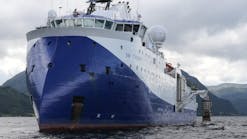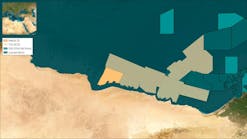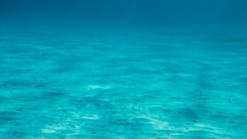David Paganie • Houston
Minimizing uncertainty key to Lower Tertiary development
Minimizing uncertainty is one of six keys to commercially develop Lower Tertiary fields in the US Gulf of Mexico, suggested Richard D’Souza, Granherne Americas/KBR, in his presentation at the Deep Offshore Technology International Conference & Exhibition in New Orleans, Louisiana.
D’Souza talked about the technical and economic challenges in developing Lower Tertiary fields. Some of the characteristics of the trend are low rock permeabilty, high pressure and temperature, deep reservoirs in deepwater, high viscosity/low GOR fluids, large salt canopies (7,000 ft [2,134 m] to >20,000 ft [6,096 m]), all remote from existing infrastructure.
Drilling and completion dominate the development cost of a Lower Tertiary well, D’Souza said. This is about 50-60% of the overall field development cost. A typical well could take 200-250 days to drill at $150-$250 million.
Lower Tertiary drilling has had a success rate of about 60% since the first discovery on Great White in 2002, but there is a high level of uncertainty in reservoir performance with no production analogs to date. MMS estimates 3-15 Bboe are recoverable in the trend.
The combination of minimizing uncertainty in reservoir performance and well productivity is one of six keys to commercially develop Lower Tertiary reserves, D’Souza explained. He pointed to three strategies to reduce uncertainty: Drillstem test (up to 60 days), extended or long-term test (6-24 months), and early production or phase development (more than three years). Ideally, the operator needs to flow a well at least 12 months to increase confidence in well rates and recovery, he said.
A drillstem test was carried out on Chevron’s Jack discovery, an extended well test has not yet been done in the GoM, and Petrobras is using a phase development approach for its Cascade-Chinook project.
In the production phase, some form of artificial lift is required to enhance recovery from Lower Tertiary wells, D’Souza said. Downhole (ESP) or mudline pumps are most effective to maintain reservoir pressure, but water injection and gas lift also are viable. Subsea boosting and processing are possibilities, but a step-change in the technology is needed to meet the technical challenges in the Lower Tertiary, he said.
Shell is using subsea processing for its Perdido development, slated for first production in late 2009/early 2010. The technologies developed for Perdido and Petrobras’ Cascade-Chinook, scheduled for first production in 2010, “will be enablers for the many Lower Tertiary discoveries in the queue,” D’Souza said.
Success rate continues
Drilling success in the Lower Tertiary continues with the Buckskin and Shenandoah discoveries. The Chevron-operated Buckskin oil discovery is in Keathley Canyon block 872 about 44 mi (71 km) west of the company’s Jack discovery.
The Buckskin No. 1 well, drilled in 6,920 ft (2,109 m) of water to 29,404 ft (8,962 m) deep, encountered more than 300 ft (91 m) of net pay.
More tests are being conducted on data gathered from the discovery well, and additional work on the field is needed to determine the extent and commercial viability of the discovery, Chevron says.
The Anadarko-operated Shenandoah discovery is in Walker Ridge block 52. The discovery well, drilled in 5,750 ft (1,753 m) of water to 30,000 ft (9,144 m) deep, encountered more than 300 ft (91 m) of net oil pay.
Anadarko and partners are evaluating the well results and the next steps toward future appraisal activity.
“Initial data indicate the Shenandoah discovery has reservoir properties that appear to be of much higher quality than industry has seen previously in the emerging Lower Tertiary play,” says Bob Daniels, Anadarko senior VP of worldwide exploration.
Anadarko also made a deepwater oil discovery at the Heidelberg prospect in Green Canyon block 859. The discovery well, drilled in 5,000 ft (1,524 m) of water to 28,500 ft (8,687 m) deep, encountered more than 200 ft (61 m) of net oil pay in several Miocene sands.
“The Heidelberg discovery further validates our geologic understanding of the subsalt Miocene trend,” Daniels says. “The well encountered the same age sands and reservoir characteristics similar to the previously announced Caesar/Tonga discoveries.”
Heidelberg’s proximity to Anadarko’s 100%-ownedConstitution spar enhances the company’s flexibility to consider a variety of development options after further appraisal, which Anadarko says it intends to conduct in the second half of this year.
Mariner Energy has made a gas discovery at the Bushwood prospect in Garden Banks block 463. The Bushwood No. 1 (formerly Geauxpher No. 3) discovery well, drilled in 2,700 ft (823 m) of water to 25,300 ft (7,711 m) deep, logged more than 260 ft (79 m) TVT of net gas pay in multiple sands, with more than 150 ft (46 m) TVT of net gas pay found in the deeper exploratory section.
Friesian offset draws parallel to Tahiti
Plains Exploration & Production Co. says data from its Friesian No. 2 discovery well show a strong correlation, both geologic and pressure, to the initial Miocene pay sands at Tahiti.
The PXP-operated well, in Green Canyon block 643 approximately 3,300 ft (1,006 m) due south of the initial discovery well, was drilled to a TD of 28,989 ft (8,836 m). It encountered approximately 389 ft (119 m) of net oil in Miocene-age sands.
These pay sands are the uppermost field pays at the Tahiti field approximately eight mi (13 km) to the west across the basin syncline, the company says.
PXP and its partner have opted to deepen the Friesian No.2 well by an additional 3,500 ft (1,067 m) to 32,500 ft (9,906 m) true vertical depth to test the main field equivalent sands such as the M15, M18, M21A, and M21B at Tahiti. Several of these Tahiti pay sands have flow tested in excess of 25,000 b/d of oil, according to PXP.
Diamond Offshore’s semisubmersible drilling rigOcean Monarch was scheduled to arrive on site in early March to begin deepening the well. First production is targeted in 2012.
In other deepwater news, Nexen says it expects first production from its Sargent discovery to come in 2010. Development plans are for a single-well tieback from the discovery well in Garden Banks block 339 to existing infrastructure in the area. The company also says a feasibility study is under way for development of the Shell-operated Vicksburg discovery in DeSoto Canyon block 353.






